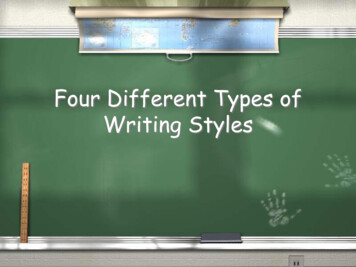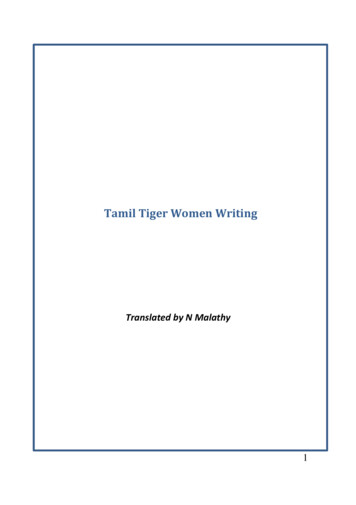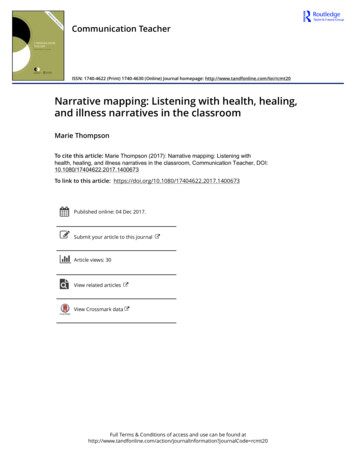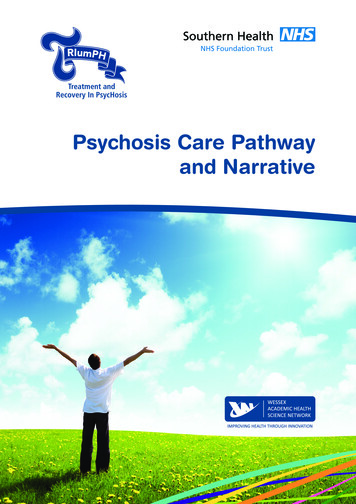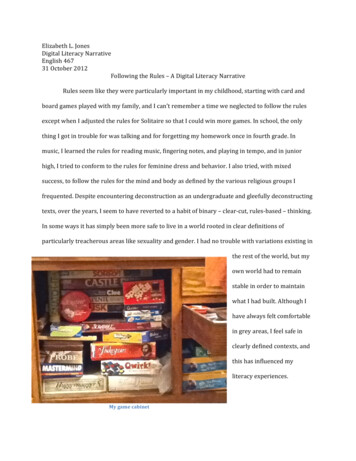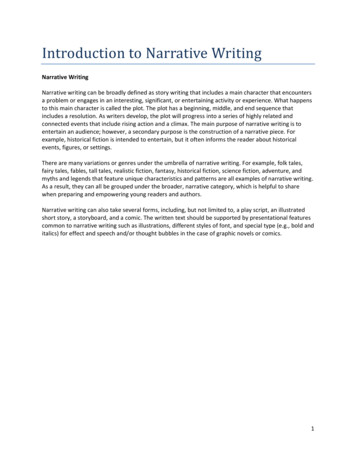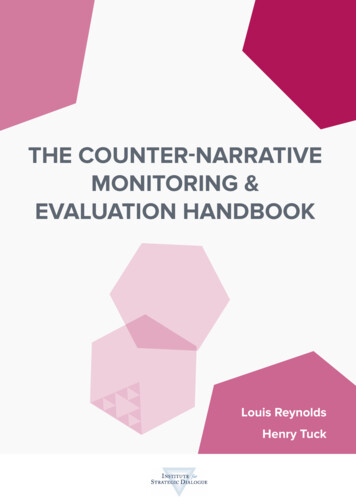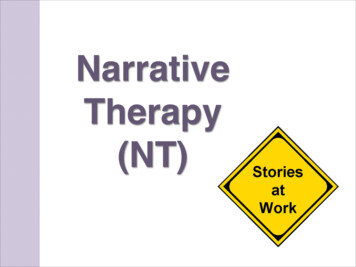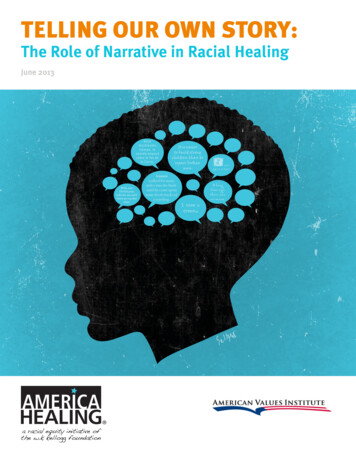
Transcription
TELLING OUR OWN STORY:The Role of Narrative in Racial HealingJune 2013 grassis itself achild. . . .theproducedbabe!A childsaid, Whatis the grass?fetching it tome withHacemuchísomotiempo, lacomida empezósobre la faz dela Tierra.of thevegetation.Or I guess it isa uniformWell, son,I’ll tell you:Life for me ain’tbeen no crystalstair.Thediscoveryimparts themacabre jelly.The plant corkwemay see andremark, and sayWhose?Or I guess theIt is easierto build strongchildren than torepair brokenmen.Anansiwalked for manymiles into the bushuntil he came uponsome fresh tracks ofa warthog.?!?dropped,Bearing theowner’s namesomeway in thecorners, thatfullhands;How could Ianswer the child?. . .I do notknow!!I have adream.jelly. Theplant corkschedules thevalue.The careOschedulesthe value.The discoveryimparts themacabrenceupon a time A longtime agothere wasno moon.Thediscoveryimparts themacabre jelly.The plantThediscoveryimparts themacabre jelly.The plant corkstuffwoven.Or I guess it is thehandkerchief of theLord, A scented giftand remembrancerdesignedlywhat itis any morethan he.I guess it must be theflag of my disposition,out of hopefulgreenThediscoveryimparts themacabre jelly. Theplant cork
REPORT AUTHORSRachel D. GodsilBrianna GoodaleAMERICAN VALUES INSTITUTEAlexis McGill Johnson, Executive DirectorRachel D. Godsil, Research DirectorRESEARCH ADVISORSJoshua Aronson, New York UniversityMatt Barreto, University of WashingtonDeAngelo Bester, NPA’s Dismantling Structural Racism ProjectLudovic Blain, Progressive Era ProjectCamille Charles, University of PennsylvaniaNilanjana Dasgupta, University of Massachusetts, AmherstRachel D. Godsil, Seton Hall University Law SchoolPhillip Atiba Goff, University of California, Los AngelesDeLeon Gray, North Carolina State UniversityJerry Kang, University of California, Los Angeles, School of Lawjohn a. powell, University of California, BerkeleyL. Song Richardson, University of Iowa College of LawLinda Tropp, University of Massachusetts, AmherstBOARD OF DIRECTORSjohn a. powell, ChairConnie Cagampang HellerSteven MenendianCover illustration by Thomas Seltzer
Make up a story. Narrative is radical, creating usat the very moment it is being created.–Toni Morrison, 1993 Nobel Lecture11Bell, Lee Anne (2010-07-01) at p. 75
TELLING OUR OWN STORY: The Role of Narrative in Racial HealingFOREWORDThe 21st Century has ushered in an era of unparalleledbrain science and related research. We are learning howwe use parts of our brains to create, store, and access notonly information, but the meaning that information holdsfor us as individuals and the implications for our society.The power of narrative or story is emerging as an importantpiece of these discoveries. It seems that, as human beings,we are always telling ourselves and others “stories” aboutexperiences and life itself. We use this warehouse of storiesto organize and “categorize” our way through life. Weliterally call up “shared stories” to help us make decisions,make meaning, and navigate situations on a daily basis.But the story of America at individual and collective levels is a story shaped by adominant vestigial belief, a carryover from the 1700’s. From the Latin, vestigium,meaning footprint, footstep, track. The vestigial belief in human hierarchy, basedon physical appearance or characteristics was first proposed by Linnaeus duringthe age of European Enlightenment. Like many ideas of that era, this concept ofhuman hierarchy or racism, has transported human enterprise to unanticipatedheights and depths. This idea was used to justify and rationalize the single mostdramatic economic expansion in human history, the institution of trans-Atlanticslavery, and to support conquering, exploiting, displacing, and discriminatingagainst entire populations within geographic areas.The now mythic American story of rugged individualism and self-determination has morphed into values that are deeply held. Unfortunately for our country’sfuture and for millions of children of color those values are grounded in a skewedor incomplete story of the making of America. The interdependent and confluentlives of diverse people could have shaped an American ethos and value systemthat embodies empathy and understanding, a more balanced interpretation ofrights, opportunity and privilege. But because dominant American values largelyemerged from a flawed ideology of assumed superiority and inferiority of humanworth, these deeply held mythologies continue to serve as barriers to cooperativeand collective action on behalf of vulnerable children and the future viability ofour nation.Telling Our Own Story: The Role of Narrative in Racial Healing provides animportant resource for leaders and practitioners working to overcome ournation’s legacy of racism. The authors present the emerging science of the powerof narrative and do so within the context of efforts by diverse communities toII
TELLING OUR OWN STORY: The Role of Narrative in Racial Healingfind effective ways of communicating and creating new, authentic stories thathonor the complexity of the past while forging a more equitable future. Advocates, researchers, and leaders across multiple domains are urged to integrate thisemerging science about the catalytic role that narrative, individual story, can playin meaningful change strategies. We are also advised to recognize that talking isa form of “action,” a precursor to decisions and collaborative efforts needed. Wewould be wise to remember that trust is a necessary foundation for shared action,and trust is anchored through experiences of gaining deeper understanding.Gail C. Christopher, D.N.Vice President for Program StrategyW. K. Kellogg FoundationFellow, National Academy of Public AdministrationIII
TELLING OUR OWN STORY: The Role of Narrative in Racial HealingTABLE OF CONTENTSIIForeword1Introduction4SECTION I: THE NEUROSCIENCE OF UNDERSTANDING NARRATIVE7A. The Neurobiology of Narrative7B. The Function of Narrative9C. The Healing Potential of Narrative11SECTION II: HOW NARRATIVE CAN SERVE SOCIO-POLITICAL PURPOSES13A. New Narrative, New Behavior, New Outcomes16B. Understanding the Power of Media Narratives in Framing Racial Narratives20SECTION III: THE ROLE OF NARRATIVE IN RACIAL HEALING24Conclusion25References
TELLING OUR OWN STORY: The Role of Narrative in Racial HealingINTRODUCTIONThis country has a series of meaning-making narrativesthat create enormous challenges for identity formation,community empowerment work, and equity advocacy.Versions of the Horatio Alger story in which a poor ladlifts himself from poverty to affluence by his bootstrapsunderlies the classic American individualist narrative,our conceptions of success and failure, as well as thenormative baseline for critiques of public policy aimed atredistributive justice and a social safety net. The “meltingpot” narrative dictates that cultural identities shouldbe subsumed under the “American” identity—and thussuggests that any ethnic group that seeks to maintain theintegrity of its language or cultural traditions is somehow“un-American.” The metaphor of the “melting pot” alsohas a cruelly ironic twist for the descendants of the initialinhabitants of the land which now constitutes the UnitedStates. The still-celebrated Columbus discovery storyflattens the many different Tribes and peoples into a singlecategory and renders invisible the rich history of indigenous communities (Blackstock, Cross, George, Brown &Formsma, 2006). The “color-blind” narrative tells us thatrace shouldn’t matter (Bell, 2011). And if race doesn’t matter,then policies seeking to address racial inequities, peoplewho identify race as salient, and any racial group’s desireto retain a distinct racial identity are “racists” or “playingthe race card” (Bonilla-Silva, Lewis & Embrick, 2004).1
TELLING OUR OWN STORY: The Role of Narrative in Racial HealingDominant narratives also pose obstacles for any who seek to move beyond theprescribed roles or characters they are supposed to play, dictating how each of us isseen. Codified through repetition, stereotypes solidify a narrative perpetuated bythe media into our culture and ultimately, through schemas, into our unconscious.These stereotypes then become the lens throughwhich individuals are viewed and treated. A Blackman is too often “seen” as potentially dangerous orpresumed to be an athlete or entertainer rather than adoctor, lawyer, teacher, or father. An Asian-Americanwoman is “seen” as deferential, and an Asian-American man as skilled in math, but socially awkward.In our current political climate, many who appearLatino or of Middle-Eastern descent are presumed tobe non-citizens: the ultimate exclusion. And outsideof historical caricatures, Native Americans are oftennot seen at all (Cross, 2013)We can challenge the dominant narratives—and we do. We are all storytellers.As children, we are told stories about our families which become central to oursense of self. Our caregivers share folktales or fairytales from their own childhoodsas a way to entertain but also to instruct. Children then begin to tell stories—abouttheir families, themselves, their adventures, their dreams. Even before they cantalk, toddlers imitate adults’ body language and enact stories through play. Thesestories we share become the form through which we view our lives and our identities. Our memories are constituted by the stories we tell (Pratt & Feise, 2004).It has always been so. Before humans were able to share information withwritten symbols, storytellers acted as storehouses of history. In every cultureand every religion, stories have played critical roles in constituting meaning,constructing identity, and prescribing behavior. Through memorable charactersand compelling events, stories stir our emotions (Chwe, 2001). We internalize theshared standards and norms of our community through our desire to emulate theheroes and dissociate ourselves with the villains. (Chwe, 2001).Storytellers teach. We learn through listening to stories and our knowledgeis largely constructed from the stories we hear (Schank & Berman, 2002). Storytelling, for Indian families, is the “greatest teaching resource for communicatingidentity, values, and life skills,” (Cross, 2013, p. 3). Stories allow us to teach andlearn in formal and informal settings. As Cross describes, “The Indian family issupported intellectually by ‘self talk’ and by the stories we hear about how othershave managed. Sitting around the kitchen table or on the front steps, we learnstrategies for interacting with the world or how to use resources” (2013, p. 3).Stories or, more formally, narratives involve a distinct way of thinking whichhumans use to complement the “paradigmatic” mode of thinking which involvescreating categories (schema) into which we store and organize the overwhelmingstimuli we experience (Bruner, 1986). The narrative mode treats experiences asunique historical events containing plots (intentions, actions, and outcomes) whichallow us to understand and interpret human activity and behavior (McAdams,2001). Our experiences hearing and telling stories create the capacity for us toIn every culture and everyreligion, stories haveplayed critical roles inconstituting meaning,constructing identity, andprescribing behavior.2
TELLING OUR OWN STORY: The Role of Narrative in Racial Healingengage in perspective taking, empathy, critical thinking, and nuanced ways ofunderstanding the world (Ochs, Taylor, Rudolph & Smith, 1992).Humans have an enormous appetite for learning about the world around them.Yet our appetites are far greater for creative stories than for dry recitations of factsor densely written academic articles. Unlike a text book, which we force ourselvesto read out of obligation, stories compel our attention for hours on end (Boyd,2009). American children read stories in bed with flashlights, teenagers sharegossip around their lockers, and adults organize their lives to catch their “stories”on television. Interest in stories and story-telling is a global phenomenon; we seekto explain the world to each other through narrative,whether we describe the stars as burning balls of gas,like Western scientists, or slivers of light droppedby Raven when the world was dark, like the Haidapeople of British Columbia (Mehl-Madrona, 2007).Each story has a point we wish to convey, leading usto adapt our narratives to fit a particular audience(Boyd, 2009). Because our brains respond so powerfully to information in the form of narratives, those ofus engaged in equity work or community empowerment ignore this form of communication at our peril.Stories are crucial not only because they engageour attention, but because of their role in creatingmeaning. They orient us to what we perceive to betrue, possible, and ideal. Stories are central to thedevelopment of our world view and the values wehold sacred (Westen, 2011). Because they are integral to structuring how we interpret events and facts,stories have been described as the “third dimension” of power (Gaventa, 1980).And, like other forms of power, stories become subtle vehicles for the dominantclass to construct and prescribe roles that lead to status differentiation. “Stock”stories lock us into caricatured roles and circumscribe our humanity (Bell, 2011).Stock stories have always met resistance—and now our increased understandingof cognitive neuroscience will help us understand how best to contest the dominant narratives of our time.We seek to explain theworld to each otherthrough narrative, whetherwe describe the stars asburning balls of gas, likeWestern scientists, orslivers of light droppedby Raven when the worldwas dark, like the Haidapeople of British Columbia.3
TELLING OUR OWN STORY: The Role of Narrative in Racial HealingSECTION I:THE NEUROSCIENCE OF UNDERSTANDING NARRATIVEModern technology allows us to witness how our brainresponds to situational cues and identify behaviorrewarding hormones and has confirmed that ourbrains are more than a static collection of anatomicalparts. Their neuroplasticity, or ability to adapt physically tochanges in our environment, renders them fluid organismsshaped by an amalgamation of narratives; memories ofour childhood, stories we have read, and lessons learnedin school all influence our perception of the world.Sometimes we are the characters in the narratives shapingour cognitive perceptions; sometimes we merely adapt andinfer from someone else’s narrative. As one neuroscientistput it, the brain is “a social organ built through experiences,” (Cozolino, 2006, p. 7). Current research on neuralfunctioning has consistently demonstrated the brain’ssuperior ability to infer themes from spoken or writtennarratives, and that our anatomy is designed to enableempathy for real or imagined characters. Put simply, ourbrain serves a social purpose, connecting us as creatures ina larger community through interwoven stories.4
TELLING OUR OWN STORY: The Role of Narrative in Racial HealingKnowing how the brain works is critical to understanding how narratives operateand influence our behavior. Most of our actions occur without our consciousawareness, triggered by stories we tell ourselves repeatedly over time. We experience the world as a complex set of visual cues, noises and symbols; as children,we learn from the people around us what to make of these experiences. From ourschoolteacher, we might learn that a skinny, fuzzy straw isa useful tool for stringing beads and creating art projects;the same object, however, takes on a different meaningwith our grandfather, who uses it to clean his pipe. Thenarratives we are told help create and reinforce the waysin which we interpret the world. In turn, the narratives welearn must necessarily come from the storytellers aroundus. As children and adults, we derive meaning from novelsensory experiences by seeking out others who have experienced the same thing. Hearing a scary noise at night asa child, we may have sought out an older adult’s opinionabout the “monster” under our bed. Their reassurance thatthe sound was only a branch tapping on the window outside helped us redefinethe narrative to be less scary. As we get older, we can recall the story of the branchon the window pane on our own, now able to interpret the sound for ourselves.We rely less on others, using their previous narratives much later even in theabsence of their presence.While we are not born knowing the uses or meanings of the stimuli aroundus, our brains also do not need an interpreter by our side, constantly creatingcontext for that stimuli. Rather, over time, our brains create categorical shortcuts(or schemas, to use the scientific phrase) for most of the sights we see and soundswe hear (Macrae & Bodenhausen, 2000; Greenwald & Banaji, 1995). This processis referred to as ‘implicit social cognition.’ We may initially define an object by aspecific story, over time, as we tell ourselves the narrative repeatedly, a neuralshortcut begins to form (Kahneman, 2003; Tversky & Kahneman, 1983). Studyinghow group members differentially interpret and negotiate their understandingsof the same task, Moscovici (1973) noted social representation, or the culturallyunderstood story given to everyday objects, serves two purposes. He concludedthat it allowed individuals “to orient themselves in their material and social worldand to master it,” while secondly, it provided members with “a code for socialexchange and a code for naming and classifying unambiguously the world andtheir individual and group history,” (p. 93). Implicit social cognition, throughwhich one’s earlier lived narratives are unknowingly influencing the outcome ofcurrent behavior, may help create continuity in the social representation of theworld. Using the language learned previously, we can relay stories and share ourexperiences with each other.Being able to identify and categorize situations or objects subconsciously andimmediately was evolutionarily critical to our ancestors’ survival and is similarlynecessary to us. In some contexts, however, it proves deeply problematic. Our“quick and dirty” processing pathway, referred to as the Fight-or-Flight response,has formed to help us react at a moment’s notice. Originally designed to helpOur brain servesa social purpose,connecting us ascreatures in a largercommunity throughinterwoven stories.5
TELLING OUR OWN STORY: The Role of Narrative in Racial Healingus flee a predator or sniff out edible berries, the acute stress response activatesinstantaneously and subconsciously to cues from our environment. A rustling inthe bushes, for example, filled our ancestors with dread and quickened their heartbeat. They would likely feel a rush of adrenaline and sudden desire to run, imagining a bear or other dangerous creature hiding in the bushes.In modern America, rarely do we need fear encountering a dangerous predator. As a result, our fight-or-flight response can be more of a hindrance than ahelp. Our implicit social cognitions extend to categories for other people as wellas objects, with judgments occurring subconsciously and instantaneously. Basedupon visual and aural cues, we make automatic assumptions about what category a particular person fits within, and how we shouldrespond to them. These categories and judgments continueto serve us well in many instances – cuing us to offersome people a seat when we identify them as an elder, forexample. When our categories are freighted with negativeassociations, however, we can often misjudge and activatethe acute stress response unnecessarily. In these instances,errors can be life-threatening—a police officer misinterpreting the object in a man’s hand as a cell phone and nota gun, for example.Following evolutionary necessity, which requiredhumans to pay greater attention to any category thatmay be a predator, categories continue to influence whatpeople pay attention to, how they organize their attention, and what they later remember (Whitley & Kite, 2010;Hamilton, 1981). These life-threatening errors have a tendency to occur more insome situations than others. In other words, categorization can activate stereotypes that hamper rather than help our assessment of how to behave or respondin a given situation (Greenwald & Banaji, 1995; Kahneman, 2003). The widespread stereotype of Black criminality makes it more likely that a cell phone willappear to be a gun if the person holding it is Black rather than White (Hamilton& Sherman, 1994).Research by Higgins, Roney, Crowe and Hymes (1994) underscores the roleof schemas in creating and perpetuating negative social bias. The researcherssuccessfully manipulated whether participants would engage in approach oravoidance strategies towards another person by changing the narrative framingtheir definition of “friendship.” Higgins et al. (1994) demonstrated how differentschemas around the same word can lead us to behave differently; in short, theirfindings suggest our narratives matter. The cognitive heuristics causing us tojudge quickly whether to approach or avoid someone also extends to stereotyping; Kahneman (2003) documented several experiments in which researchersfound participants repeatedly employed implicit biases in forming opinionsabout a hypothetical character. When participants had stereotypes about how afeminist activist usually behaves, for example, they were much more likely toindicate the character was a feminist banker if she had gone to an antinucleararms rally, even though the probability of being both a banker AND a feministCategorization canactivate stereotypesthat hamper ratherthan help ourassessment of howto behave or respondin a given situation.6
TELLING OUR OWN STORY: The Role of Narrative in Racial Healingwas much lower than just being a banker. Stereotypes serve as one example of amaladaptive schema, pervading our implicit social cognitions and subconsciouslyaffecting our behavior.Narratives encompass the broader schemas and implicit theories that organize our responses to the world. They impact how we view the world and makemeaning from sensory perceptions. The ways in which socialization helps usunderstand behavior in turn influences the schemas for how we interpret ambiguous stimuli. The stories on repeat in our minds interact with our biology, makingus more or less likely to approach a situation. The narrative we build has thepotential to negate or perpetuate social biases.A. The Neurobiology of NarrativeUsing functional Magnetic Resonance Imaging (fMRIs) and Positron Emission Tomography (PET) machines, modern scientists have successfully isolatedand identified areas of the brain which respond to events in our surroundings.Researchers can take pictures of participants’ brains and compare what sections“light up” when completing various activities. Given scanning techniques haveonly developed in the last few decades and remain extremely expensive to implement, little research has directly identified cognitive regions related to narrativeunderstanding. Cobbling together studies from across many disciplines into oneof the few reviews on the neuroscience of narrative, Mar (2004) speculates aboutareas potentially associated with story-making. He notes the role of our frontallobe in processing information and language, as well as the activation of the righthemisphere when participants were asked to make inferences from a given set ofsentences. Other researchers have similarly demonstratedthe importance of this region in sense-making, describingpatients who suffered from right-hemisphere strokes asable to articulate sentences and complete tests but sufferingfrom language comprehension impairment (Beeman &Chiarello, 1998). Although research on the neuroscience ofstory-telling and comprehension remains relatively sparse,initial findings suggest certain hardwired circuits weredesigned specifically to process social narratives.Narrative storiesrequired less semanticprocessing than readingstrict facts aboutan issue, suggestingindividuals expendless mental energyto comprehend astory than to inferstrict informationdevoid of context.B. The Function of NarrativeIf we can reliably say areas facilitating narrative comprehension exist in our brains, the question becomes why didthey evolve? What function do these centers serve? Andhow can we use the narrative centers to aid in our quest forracial healing? Comparing narrative story-telling to othermethods of information transmission may help illuminatepossible answers.Because we rely on past experiences and learned lessonsto inform our future decisions, narratives may have arisen as a mental shortcutfor comprehending another person’s experience. Baretta, Tomitch, MacNair, Limand Waldie (2009) found narrative stories required less semantic processing than7
TELLING OUR OWN STORY: The Role of Narrative in Racial Healingreading strict facts about an issue, suggesting individuals expend less mentalenergy to comprehend a story than to infer strict information devoid of context.Narratives implicitly create a “situation model,” where readers can tap into themicroworld of its characters and relate to their experiences (Boyd, 2009). Expositions simply relate facts, while narratives transmit themes through a seriesof events. They build on shared cultural knowledge (Graesser, Olde, & Klettke,2002), requiring listeners or readers to import background information to understand references (Baretta et al., 2009). Narrative becomes a faster vehicle fortransmitting information since individuals need not spend time or mental energyconstructing a setting for its goals; its characters, events, or stage may be familiarto its audience. Freed from having to situate the information in a relatable venue,individuals can more quickly infer meaning from narratives than from a series ofunrelated facts. Specialized centers for processing narrative information, like theright hemisphere or the frontal lobe, may have developed to help expedite sensemaking and reduce mental load.The ability to infer information more quickly serves a social function, asnarratives transmit messages about certain behavior’s acceptability as well asencouraging altruism. The areas associated with narrative comprehension developseparately from the speech production centers in the brain (Awad, Warren, Scott,Turkheimer & Wise, 2007), supporting the idea that we maybe able to understand narratives well before we can talk.Our responses to narrative stimuli may be hardwired froman early age. Developed before age two, certain neuronsin the human brain allow us to recognize the differencebetween biological and non-biological movement; newbornbabies will imitate another human within hours of birth,and children frequently reenact modeled play (Boyd, 2009).We may gain the ability to comprehend stories well beforewe can perpetuate them verbally. Furthermore, researchsuggests the process of envisioning a recounted narrative arises innately, neither specific to a given culture nordevelopmentally learned (Boyd, 2009). Across populations,children demonstrate a similar ability early on to comprehend the narrative around them and adjust their behavior accordingly. Childrenas young as a year old, still lacking language production capabilities, have beenshown to recognize and respond to distress in adults (Boyd, 2009). Although notnecessarily vocalized, narratives can help create interpersonal empathy from anearly age.In addition to creating social affinity, the ability to understand narratives mayserve as a heuristic for figuring out acceptable or unacceptable social behavior(Boyd, 2009). We tell our children stories about The Little Engine That Could toencourage them to keep trying in the face of adversity, or about our own positiveexperiences at the dentist to help them feel less afraid. Before they can write oreven formally verbalize their own stories, children often partake in narrative play(Boyd, 2009); their interactions may not follow a logical pattern, but they nevertheless engage in peer communication about acceptable acts. Whether real-worldAcross populations,children demonstratea similar ability earlyon to comprehendthe narrative aroundthem and adjust theirbehavior accordingly.8
TELLING OUR OWN STORY: The Role of Narrative in Racial Healingtales or fictional accounts, our narratives transmit ideas and messages to our audience; we tell them with a purpose of achieving a goal. The ability to deduce thisgoal rapidly allows us to communicate more smoothly and increases potentialemotional affinity.C. The Healing Potential of NarrativeWith an early predisposition towards narrative comprehension, we may benefitfrom transforming our dialogues around community well-being into empathygenerating stories. Mehl-Madrona (2007) has argued for a similar metamorphismin healthcare, asserting conventional medicine fails to consider an individual’ssocial context. His comparisons for healing in the physicaldomain may help inform suggestions for racial healing.Like Western medicine, all too often we look for a simplecause-and-effect relationship between two variables. This“linear” worldview stands in contrast with the multidimensional “relational” or “cyclical” world view rootedin tribal cultures (Cross, 2013). Rather than a mechanisticexplanation, we need to evaluate how the system of variables contributes to outcomes in stigmatized communities.Racist behavior and attitudes stem from a larger flawedcontext encouraging and even rewarding discrimination.Practices such as Indian child removal by the child welfare systems result from aset of long-entrenched, institutionalized norms (Blackstock, Cross, George, Brown& Formsma, 2006). Any feasible solutions for healing need to have a communityand systems focus, recognizing that “curing” a single individual cannot eradicatethe conditions.While only recently has Western science explored the implications of narrative form on well-being, Native American tribal elder
Storytellers teach. We learn through listening to stories and our knowledge is largely constructed from the stories we hear (Schank & Berman, 2002). Story-telling, for Indian families, is the "greatest teaching resource for communicating identity, values, and life skills," (Cross, 2013, p. 3). Stories allow us to teach and


